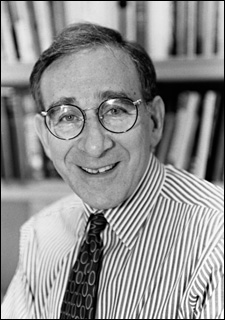Merton Bernfield
Faculty of Medicine – Memorial Minute
“The Master in the art of living makes little distinction between his work and his play, his labor and his leisure, his mind and his body, his education and his recreation, his love and his religion. He hardly knows which is which. He simply pursues his vision of excellence in whatever he does, leaving others to decide whether he is working or playing. To him he is always doing both.”
– Zen Buddhist text
Merton Bernfield, the Clement A. Smith Professor of Pediatrics and Professor of Cell Biology at Harvard Medical School, and Chief of the Division of Newborn Medicine at Children’s Hospital Boston, passed away on March 18, 2002, following an episode of pneumonia caused by a rapidly progressive form of Parkinson’s disease. He was a good friend, an inspiring teacher, a skillful and caring clinician, a supportive and responsible colleague, a conscientious mentor of students at every stage in their career, and an innovative and creative scientist.

Mert was born in 1938 in Chicago. He married his high school sweetheart, Audrey Rivkin, in 1959. Audrey and Mert remained committed partners and best friends until his death. A devoted father to Susan, James and Mark, he was proud of his children for their independence of spirit, which he and Audrey encouraged. He also loved spending time with his two grandchildren.
Mert attended public school, graduated medical school at the University of Illinois, and specialized in pediatrics, ultimately neonatology. He developed an interest in embryology and cellular organization. After a postdoc with Marshall Nirenberg at the NIH in 1963, Mert moved to Clifford Grobstein’s laboratory at UCSD to study embryonic developmental biology. Here Mert helped found the virtually unknown area of glycobiology, which today is at the forefront of cell and developmental biology. At that time, the extracellular matrix was considered what the name implied: something outside the cell. It was believed to be merely a physical and static support with only limited influence on the important cellular decisions of growth and differentiation. But Mert would help lead the way in changing that perception.
After leaving UCSD for Stanford, Mert served as Chief Resident in Pediatrics and rose to full professor of Human Biology and Pediatrics. In the 1970s, studying glandular development, Mert showed first that the extracellular matrix was very dynamic, turning over at points of growth and morphogenesis. Mert and his colleagues went on to discover the first syndecans, transmembrane heparan sulfate proteoglycans, which connect across the plasma membrane to the actin cytoskeleton. The extracellular domains mediate a large variety of functions, including cell adhesion and the presentation of growth factors to signaling receptors. The importance of the extracellular matrix components in intercellular signaling was another of Mert’s insights that is now key to cell and developmental biology. From these seminal observations, the importance of the matrix, and the syndecans in particular, may be boundless.
During this period of demanding clinical and research work, Mert found time to take over the innovative Human Biology Program for undergraduate students and indulge his love of teaching. There are many students today who trace their interest in science to the years in that program, which Mert so lovingly nurtured.
Mert came to Harvard as head of the Joint Program in Neonatology in 1989 and Chief of the Division of Newborn Medicine at Children’s Hospital. For the next thirteen years, he continued to build his research program as well as the careers of many talented neonatologists. Toward the end of his life, Mert’s focus and productivity continued, and perhaps even accelerated. In his last year, Mert and his colleagues published their far-reaching genetic investigations of the syndecan family members, describing their important role in obesity, cancer and bacterial pathogenesis.
Mert’s enthusiasm for science was infectious. It was part of his insatiable curiosity about everything that touched him. Mert almost always had a manuscript or grant application in his hand, whether he was in his office, in a meeting, at a conference, or at home. Mert had the utmost respect for the collegiality of the scientific community, and was quick to share his insights and the new discoveries from his lab with anyone who would listen. Ever the interdisciplinarian, he would knock on all of our office doors to discuss his work. He would say, “this is very important,” and with a twinkle in his eye, he would explain why.
His investigative sense extended to himself. As his disease progressed more rapidly, he hypothesized that it was triggered by an hypoxic episode he had while traveling in the Himalayas. Even as he grew ill, he and Audrey traveled on other long journeys to Australia, Tanzania and Egypt.
One never knew if Mert was working or playing. Like the Zen master, he was doing both. Mert was concerned about the balance between career and family, a balance that eludes many of us engaged in scientific inquiry and the care of patients. His way of dealing with this was to blend them together, so that to him, he was perpetually doing both.
In November of 2001, Mert’s successor as Chief of Newborn Medicine orchestrated a symposium in tribute to Mert. It was a testament to Mert’s ideas, his friendship, and his love. Former students, fellows, colleagues and relatives came from all over the world. It was a festive scientific and personal occasion, looking back at careers and relationships and forward to new careers and new science. With humor and hard science interlaced, it was vintage Mert, and all of us wished fervently for a few more years of Mert’s wisdom, energy and humor. Instead we were granted only four months.
Respectfully submitted,
Joseph Majzoub, Chairperson
Audrey Bernfield
Marc Kirschner
Harvey Lodish
Richard Hynes




